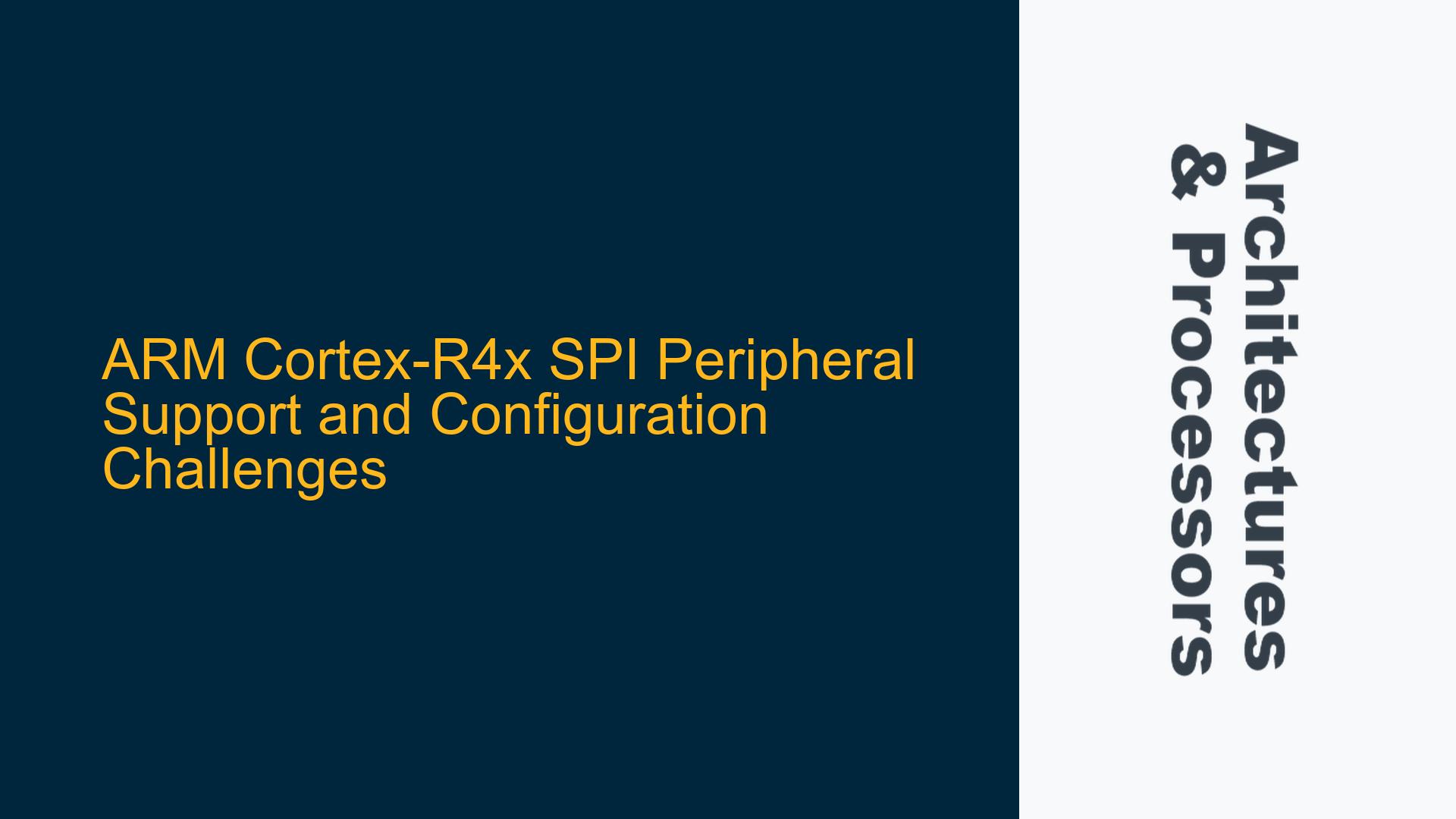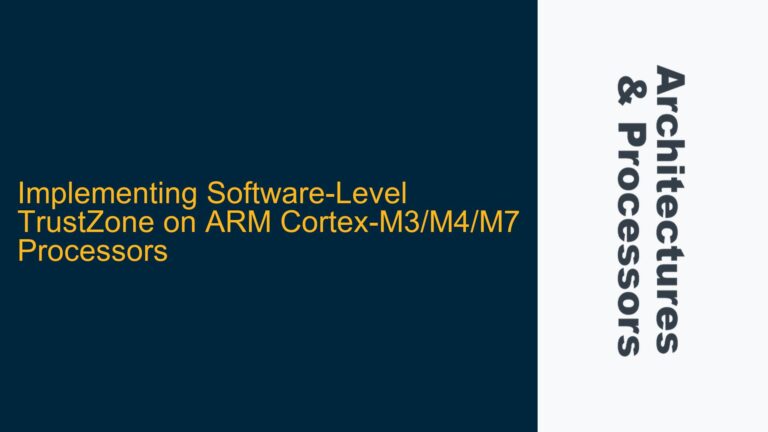ARM Cortex-R4x SPI Peripheral Integration and Documentation Gaps
The ARM Cortex-R4x series, particularly when integrated into System-on-Chip (SoC) designs like the Texas Instruments IWR1642, often presents challenges related to peripheral support and documentation clarity. One such issue is the integration and configuration of Serial Peripheral Interface (SPI) peripherals. While the IWR1642 datasheet mentions the presence of two SPI interfaces, the Cortex-R4x technical reference manual (TRM) does not explicitly detail SPI support. This discrepancy can lead to confusion during development, especially when attempting to configure and utilize these peripherals in embedded applications.
The Cortex-R4x is a high-performance real-time processor designed for safety-critical and real-time applications. It features a dual-core configuration with advanced error correction and fault tolerance mechanisms. However, the processor itself does not inherently include SPI peripherals. Instead, SPI functionality is typically implemented by the SoC vendor, in this case, Texas Instruments, as part of the broader system integration. This separation between processor core and peripheral implementation is a common design pattern in embedded systems but can lead to documentation gaps and integration challenges.
The IWR1642 datasheet indicates the presence of two SPI interfaces, but developers often struggle to find corresponding details in the Cortex-R4x TRM. This is because the TRM focuses on the processor core architecture, including the instruction set, memory management, and core peripherals like timers and interrupt controllers. SPI peripherals, being part of the SoC’s peripheral set, are documented in the SoC-specific documentation rather than the processor TRM. This division of documentation can create confusion, especially for developers transitioning from other ARM cores where SPI support might be more explicitly detailed in the processor documentation.
To address this issue, developers must understand the distinction between processor core features and SoC-integrated peripherals. The Cortex-R4x core provides the computational and control capabilities, while the SoC vendor integrates additional peripherals like SPI, I2C, UART, and others. This modular approach allows for flexibility in SoC design but requires developers to consult both the processor TRM and the SoC-specific documentation to gain a complete understanding of the system’s capabilities.
SPI Peripheral Implementation and Configuration Challenges in Cortex-R4x-Based SoCs
The implementation of SPI peripherals in Cortex-R4x-based SoCs like the IWR1642 involves several layers of complexity. First, the SPI peripheral must be mapped into the processor’s memory space, allowing the Cortex-R4x core to access and control the SPI interface. This memory mapping is typically defined in the SoC’s memory map, which is detailed in the SoC-specific documentation. Developers must ensure that the SPI peripheral’s base address, register offsets, and interrupt mappings are correctly configured in their firmware.
Second, the SPI peripheral’s operation must be synchronized with the Cortex-R4x core’s execution. This involves configuring the SPI clock, data frame format, and transfer mode (e.g., master or slave). The Cortex-R4x core’s real-time capabilities are particularly important here, as SPI communications often require precise timing and low latency. Developers must carefully configure the SPI peripheral’s clock divider and ensure that the core’s interrupt handling is optimized to minimize latency during SPI transactions.
Third, the SPI peripheral’s integration with the Cortex-R4x core’s memory system must be considered. The Cortex-R4x features a high-performance memory system with caches and tightly coupled memory (TCM). SPI transactions often involve direct memory access (DMA) to transfer data between the SPI peripheral and memory. Developers must ensure that the memory system is configured to support DMA transfers, including proper cache coherency management. This may involve using memory barriers or cache maintenance operations to ensure that data is correctly synchronized between the SPI peripheral and memory.
Finally, the SPI peripheral’s configuration and operation must be validated through thorough testing. This includes verifying that the SPI clock and data signals meet the required timing specifications, that data is correctly transferred between the SPI peripheral and memory, and that the SPI interface operates reliably under various conditions. Developers should use oscilloscopes or logic analyzers to capture and analyze SPI signals, ensuring that the interface meets the system’s requirements.
Configuring and Troubleshooting SPI Peripherals in Cortex-R4x-Based Systems
To configure and troubleshoot SPI peripherals in Cortex-R4x-based systems like the IWR1642, developers should follow a structured approach. First, they should consult the SoC-specific documentation to identify the SPI peripheral’s memory-mapped registers and configuration options. This includes the SPI control register, status register, data register, and clock configuration register. Developers should also review the SoC’s memory map to determine the SPI peripheral’s base address and interrupt mapping.
Next, developers should configure the SPI peripheral’s clock and data frame format. This involves setting the SPI clock divider to achieve the desired baud rate and configuring the data frame format (e.g., data width, clock polarity, and phase). The Cortex-R4x core’s real-time capabilities can be leveraged to ensure precise timing for SPI transactions. Developers should also configure the SPI peripheral’s interrupt settings, ensuring that the core can respond quickly to SPI events.
Once the SPI peripheral is configured, developers should implement the necessary firmware to initialize and control the SPI interface. This includes writing to the SPI control register to enable the interface, configuring the data frame format, and setting up DMA transfers if necessary. Developers should also implement interrupt service routines (ISRs) to handle SPI events, such as data reception or transmission completion.
During testing, developers should use debugging tools to monitor the SPI peripheral’s operation. This includes using an oscilloscope or logic analyzer to capture SPI signals and verify that the clock and data signals meet the required timing specifications. Developers should also use the Cortex-R4x core’s debugging capabilities, such as breakpoints and watchpoints, to monitor the SPI peripheral’s registers and ensure that data is correctly transferred between the SPI peripheral and memory.
If issues arise during testing, developers should systematically troubleshoot the SPI interface. This includes verifying that the SPI peripheral’s clock and data frame format are correctly configured, that the memory system is properly configured to support DMA transfers, and that the SPI interface’s interrupt handling is optimized for low latency. Developers should also check for potential hardware issues, such as signal integrity problems or incorrect wiring of the SPI interface.
In conclusion, configuring and troubleshooting SPI peripherals in Cortex-R4x-based systems requires a thorough understanding of both the processor core and the SoC-specific peripheral implementation. By following a structured approach and leveraging the Cortex-R4x core’s real-time capabilities, developers can successfully integrate and optimize SPI interfaces in their embedded applications.






